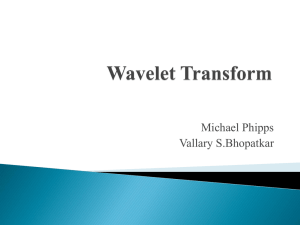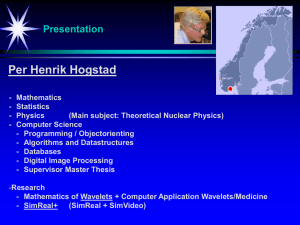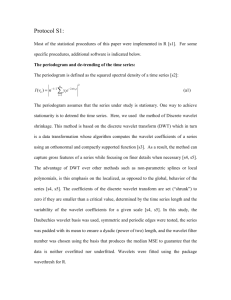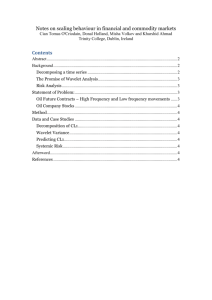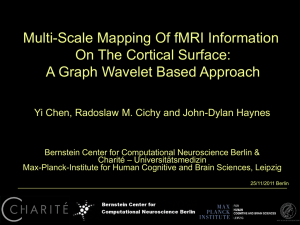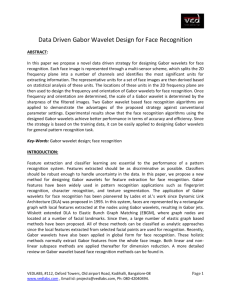Human Face Recognition using Wavelet Transform based Approach
advertisement
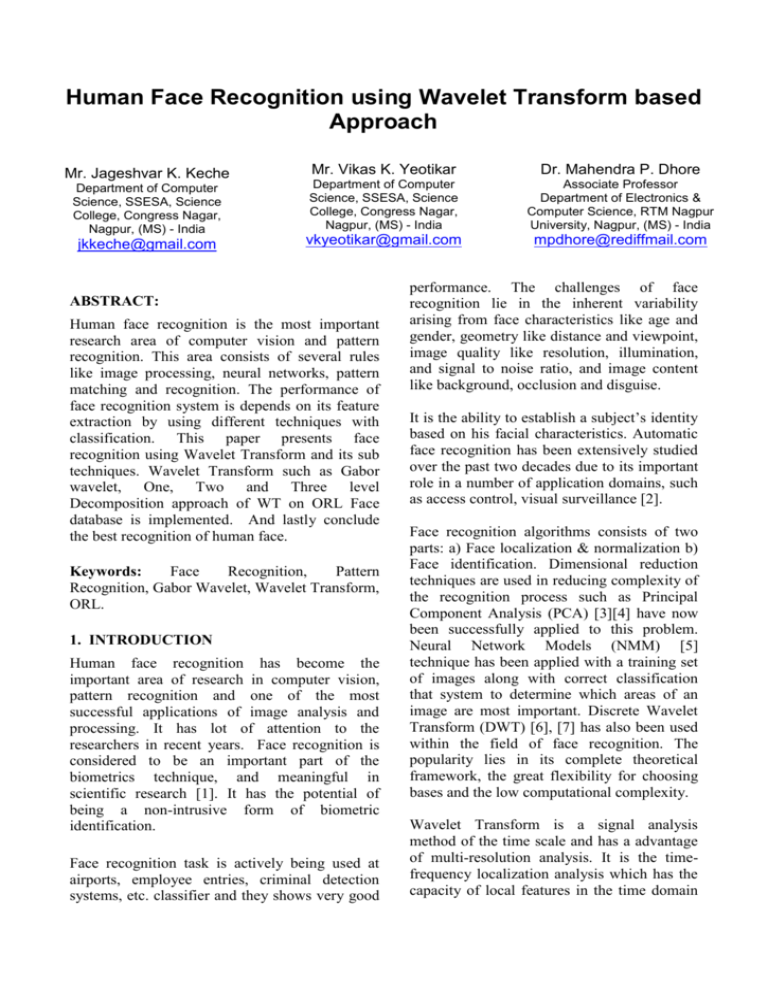
Human Face Recognition using Wavelet Transform based Approach Mr. Jageshvar K. Keche Department of Computer Science, SSESA, Science College, Congress Nagar, Nagpur, (MS) - India jkkeche@gmail.com Mr. Vikas K. Yeotikar Dr. Mahendra P. Dhore Department of Computer Science, SSESA, Science College, Congress Nagar, Nagpur, (MS) - India Associate Professor Department of Electronics & Computer Science, RTM Nagpur University, Nagpur, (MS) - India vkyeotikar@gmail.com mpdhore@rediffmail.com ABSTRACT: Human face recognition is the most important research area of computer vision and pattern recognition. This area consists of several rules like image processing, neural networks, pattern matching and recognition. The performance of face recognition system is depends on its feature extraction by using different techniques with classification. This paper presents face recognition using Wavelet Transform and its sub techniques. Wavelet Transform such as Gabor wavelet, One, Two and Three level Decomposition approach of WT on ORL Face database is implemented. And lastly conclude the best recognition of human face. Keywords: Face Recognition, Pattern Recognition, Gabor Wavelet, Wavelet Transform, ORL. 1. INTRODUCTION Human face recognition has become the important area of research in computer vision, pattern recognition and one of the most successful applications of image analysis and processing. It has lot of attention to the researchers in recent years. Face recognition is considered to be an important part of the biometrics technique, and meaningful in scientific research [1]. It has the potential of being a non-intrusive form of biometric identification. Face recognition task is actively being used at airports, employee entries, criminal detection systems, etc. classifier and they shows very good performance. The challenges of face recognition lie in the inherent variability arising from face characteristics like age and gender, geometry like distance and viewpoint, image quality like resolution, illumination, and signal to noise ratio, and image content like background, occlusion and disguise. It is the ability to establish a subject’s identity based on his facial characteristics. Automatic face recognition has been extensively studied over the past two decades due to its important role in a number of application domains, such as access control, visual surveillance [2]. Face recognition algorithms consists of two parts: a) Face localization & normalization b) Face identification. Dimensional reduction techniques are used in reducing complexity of the recognition process such as Principal Component Analysis (PCA) [3][4] have now been successfully applied to this problem. Neural Network Models (NMM) [5] technique has been applied with a training set of images along with correct classification that system to determine which areas of an image are most important. Discrete Wavelet Transform (DWT) [6], [7] has also been used within the field of face recognition. The popularity lies in its complete theoretical framework, the great flexibility for choosing bases and the low computational complexity. Wavelet Transform is a signal analysis method of the time scale and has a advantage of multi-resolution analysis. It is the timefrequency localization analysis which has the capacity of local features in the time domain and frequency domain. Wavelet decomposition is a multilevel dimension reduction process that makes time–space–frequency analysis. Unlike Fourier trans-form, which provides only frequency analysis of signals, wavelet transforms provide time–frequency analysis, which is particularly useful for pattern recognition. In this paper, we studied and presented face recognition using Wavelet Transform techniques. The rest of this paper is organized as follows. Section II extends the feature mapping, which also introduces and discusses the Wavelet Transform and its sub-techniques in detail. In Section III, shows experiments on ORL face database. Finally, conclusions are drawn in Section IV with some discussions. 2. PATTERN RECOGNITION Pattern recognition is a field within the area of machine learning. Alternatively, it can be defined as “the act of taking in raw data and taking an action based on the category of the data”. It is a collection of methods for supervised learning. Pattern recognition aims to classify data or patterns based on either a prior knowledge or on statistical information extracted from the patterns. The patterns to be classified are usually groups of measurements or observations that define points in an appropriate multidimensional space. The classification is usually based on the availability of a set of patterns that have already been classified or described. This set of patterns is termed the training set and the resulting learning strategy is characterized as supervised learning. From the past 20 to 30 years, the growth of pattern recognition increases day by day. The applications of pattern recognition includes: identification of human faces and fingerprints; automatic recognition; character recognition; remote sensing; medical diagnosis; biomedical signal and image analysis; and many others. Pattern recognition methods are classified into two categories: structural methods and feature space methods. The structural methods are useful in situation where the different classes of entity can be distinguished from each other by structural information. For e.g. the different letters of the alphabet are structurally different from each other in character recognition. The earliestdeveloped structural methods based on formal grammars to describe the structure of an entity. The machine vision method may be structural and based on point distribution models, active contours, etc [8]. In featurespace methods, a set of measurements (typically numerical) is made on each realworld entity (pattern), and from the measurement set there is extracted a set of features which together characterize the class of patterns to which the given pattern belongs. The feature-space pattern recognition is the statistical approach, where the boundaries between the regions representing pattern classes in feature space are found by statistical inference based on a design set of sample patterns of known class members [8]. The traditional goal of feature extraction is to characterize the object to be recognized by measurements whose values are very similar for objects in the same category and very different for objects in different categories. This idea of seeking distinguishing features that are invariant to irrelevant transformations of the input. The task of the classifier component proper of a full system is to use the feature vector provided by the feature extractor to assign the object to a category [9]. Image classification is implemented by computing the similarity score between a target feature vector and a query feature vector [10]. 2.1. Gabor Wavelet Gabor wavelet captures the properties of orientation selectivity, spatial localization and optimally localized in the space and frequency domains. It has been extensively and successfully used in face recognition [12]. The 2D Gabor wavelet representation pioneered by Daugman in computer vision in 1980’s [11]. The characteristics of Gabor wavelets are quite similar to those of human visual system for frequency and orientation representations. This Gabor-wavelet based extraction of features directly from the graylevel images is successful and widely been applied to texture segmentation and fingerprint recognition. The commonly used 2-D Gabor filters in face recognition area [12-13] are defined as in Eq. (1) Where, 𝑓𝑢 and 𝜃𝑣 defines the orientation and scale of the Gabor wavelets, 𝑓𝑚𝑎𝑥 is the maximum central frequency and √2 is the spacing factor between different central frequencies. Fig.1 shows a family of Gabor wavelets. …(1) Where, f is the frequency of the modulating sinusoidal plane wave and 𝜃 is the orientation of the major axis of the elliptical Gaussian. The modified Gabor wavelet is defined as: ..(2) Where, K is an offset parameter dependent on 𝛾 and 𝜂. The Gabor wavelet is used as the discrete wavelet transform with either continuous or discrete input signal. There is an intrinsic disadvantage in the constraints 1-D and 2-D Gabor wavelets. When extracting the features for pattern recognition, retrieval, or computer vision purpose, the transformed coefficients are used for distance measure or compressed representation but not for reconstruction, so the orthogonal constraint could be omitted. There are some other equivalent definitions of the Gabor wavelets and it is defined as: …(3) Where, 𝑘 =2𝜋𝑓𝑒𝑥𝑝(𝑗𝜃), and the scaling functions for the two elliptical axes are the same as 𝜎. For most of the applications, a family of 𝑈×𝑉 Gabor wavelets is usually required to perform the multiresolution and multi-orientation analysis, which is defined as below [14]: ..(4) Fig. 1 Gabor wavelets with 5 scales and 8 orientations 2.2 Wavelet Transform Wavelets are functions that satisfy certain mathematical requirements and are used in presenting data or other functions, similar to sines and cosines in the Fourier transform. However, it represents data at different scales or resolutions, which distinguishes it from the Fourier transform. Wavelet transform is an increasingly popular tool in computer vision and image processing. Many applications, such as compression, detection, recognition, image retrieval have been investigated. Wavelet transform has nice features of space-frequency localization and multi-resolutions. The wavelet transform of a 1-D signal f(x) is defined as: …(5) The mother wavelet Ψ has to satisfy the admissibility criterion to ensure that it is a localized zero-mean function. Equation (5) can be discretized by restraining α and b to a discrete lattice. Typically, some more constraints are imposed on Ψ to ensure that the transform is non-redundant, complete and constitutes a multi-resolution representation of the original signal. 2-D DWT is generally carried out using a separable approach, by first calculating the 1-D DWT on the rows, and then the 1-D DWT on the columns : DWTn[DWTm[x[m,n]]. Two-dimensional Wavelet Transform decomposes an image into 4 “sub-bands” that are localized in frequency and orientation, by LL, HL, LH, HH. LL1 HL1 LH1 HH1 (a) LL2 HL2 HL1 LH2 HH2 LH1 HH1 (b) LL3 HL3 LH3 HH3 frequency component of the image. Second level decomposition can then be conducted on the LL sub band. Fig.2(b) shows a two-level wavelet decomposition of different images of size 112X92 pixels. Earlier studies concluded that information in low spatial frequency bands play a dominant role in face recognition. Nastar et al. has investigated the relationship between variations in facial appearance and their deformation spectrums [15]. They found that facial expressions and small occlusions affect the intensity manifold locally. Under frequency-based representation, only highfrequency spectrum is affected, called highfrequency phenomenon. Moreover, changes in pose or scale of a face affect the intensity manifold globally, in which only their lowfrequency spectrum is affected, called lowfrequency phenomenon. Further decomposition to the LL sub-band (two-level decomposition), leads to lower dimensionalities and a multi resolution image. We performed three level decomposition which as shown in fig. 2(c). The number of levels we choose depends on our work and need. HL2 HL1 LH2 LH1 HH2 HH1 (c) Fig.2 Discrete Wavelet Transform : a) 1-D DWT b) 2 level 2-D DWT c) 3 level 2-D DWT Each of these sub bands can be thought of as a smaller version of the image representing different image properties. The band LL is a closer approximation to the original image. The bands LH and HL record the changes of the image along horizontal and vertical directions, respectively. The HH band shows the high Fig.3 RMS error V.S. Threshold Pt. plot in MATLAB The Root Mean Square (RMS) Error (also called the root mean square deviation, RMSD) is a frequently used measure of the difference between values predicted by a model and the values actually observed from the environment that is being modeled. These individual differences are also called residuals, and the RMSE serves to aggregate them into a single measure of predictive power. The RMSE of a model prediction with respect to the estimated variable Xmodel is defined as the square root of the mean squared error: RMSE n i 1 ( X obs,i X mo del ,i ) 2 n …(6) Where, Xobs is observed values and Xmodel is modeled values at time/place i. 3. ORL FACE DATABASE (400 images of 10 different peoples) AT&T Laboratories Cambridge was founded in 1986 as the Olivetti Research Laboratory, better known as ORL. This directory contains a set of faces taken between April 1992 and April 1994 at the Olivetti Research Laboratory in Cambridge, UK. There are 10 different images of 40 distinct subjects. For some of the subjects, the images were taken at different times, varying lighting slightly, facial expressions (open/closed eyes, smiling/non-smiling) and facial details (glasses/no-glasses). All the images are taken against a dark homogeneous background and the subjects are in up-right, frontal position (with tolerance for some side movement). The ORL Face Database was manually altering the file format into Portable Grey Map (PGM) using suitable image processing software. The PGM format is chosen because it is a lowest common denominator grayscale image file format. The files are in PGM format and can be converted into other image format like .png or .tif. The size of each image is 92x112, 8-bit grey levels. The images are organized in 40 directories (one for each subject). Fig. 4 Some face images from ORL database 4. EXPERIMENTAL RESULTS We used MATLAB 7.6.0(R2008a) to implement all the experiments of Gabor wavelets and Wavelet decompositions on different face images of ORL database. The original images and its features of some face images as shown below. Fig.5 Original image from ORL database (a) (b) (c) (d) Fig.8 Two level 2-D Wavelet Decomposition (e) (g) (f) (h) Fig.6 Gabor Wavelets (a),(c),(e),(g) and its filters(b),(d),(f),(h) on different values of theta (𝜃=0, pi/4, pi/2, 3pi/4) from fig.5 We define the five parameters to extract the features using Gabor Wavelet (filter) in Eq. 1. The parameter values are theta=0; lambda=3.5; gamma=0.3; sigma=2.8; psi=0. By changing the values of 𝜃 from 𝜃 =0, pi/4, pi/2 and 3pi/4, the extracted features of Gabor wavelets and its filters are shown in figure 6. To find this result, we used ORL face database. Fig.7 1-D Wavelet Decomposition Fig.9 Three level 2-D Wavelet Decomposition Again ORL face database is used to find the Wavelet decomposition results. Figure 7 shows the result of 1-D Wavelet decomposition. One, Two and Three level 2Dimensional Wavelet Transform decomposes an image into 4 “sub-bands” that are localized in frequency and orientation, by LL, HL, LH, HH. The band LL is a very closer approximation to the original image. The bands LH and HL record the changes of the image along horizontal and vertical directions, respectively. The HH band shows the high frequency component of the image. Figure 8 shows two-level 2-D Wavelet decomposition and Figure 9 shows a three-level 2-D Wavelet decomposition of two different images of size 112X92 pixels. Figure 10 shows the 3D plotted graph of Multi-resolution Discrete Wavelet analysis in MATLAB. [3] M. Turk and A. Pentland “Eigenfaces for Recognition”, J. Cognitive NeuroScience, vol. 3, pp. 71-86, 1991. [4] B. Moghaddan, W. Wahid and A. Pentland, “Beyond Eigenfaces: Probabilistic Matching for Face Recognition”, Proceedings of Face and Gesture Recognition, pp 30-35, 1998. [5] M. Bicego, U. Castellani and V. Murino “Using Hidden Markov Models and Wavelets for face recognition” ICIAP’03, 12th International Conference on Image Analysis and Processing,September 17-19, 2003. [6] E. J. Stollnitz, T. D. DeRose and D. H. Salesin" Wavelets for computer graphics: a primer, part I,"IEEE Computer Graphics and Applications, vol.15, No. 3, pp. 76-84, May 1995. [7] M. Harandi, M. Ahmadabadi and B. Araabi “FaceRecognition Using Reinforcement Learning”Proceedings of ICIP’04, International Conference on Image Processing. [8] Daisheng Luo, Pattern Recognition and Image Processing (Horwood Publishing Limited 1998), pp 2-3. [9] Richard O. Duda, Peter E. Hart, David G. Stork, Pattern Classification (John Wiley 2001), pp 1112. Fig.10 Multi-resolution Discrete Wavelet 3D Plot in MATLAB 5. CONCLUSION AND FUTURE WORK In this research paper we studied the Gabor, Wavelet (filter) and Wavelet Transform with respect to filtering the face feature and decomposing the original face image respectively. The 2-D Wavelet Transform is to capture the variations in faces. Experimental results on an extensive set of ORL face database demonstrate the MATLAB implementation for identification. Experiments conducted on various face conditions, including different angles, expressions etc. Future work includes more improvement in identification of number of face images. Further implementing the new method with more multiresolution transforms and finding the transform which will give maximum recognition rate. The further research-orientation in the future is to design the algorithm which gives more accurate face recognition. REFERENCES [1] [2] Jiarui Zhou, Zhen Ji, Linlin Shen, Zexuan Zhu and Siping Chen, "PSO Based Memetic Algorithm for Face Recognition Gabor Filters Selection", IEEE Conference Memetic Computing (MC), 2011, pp.1- 6. Anil K. Jain, Brendan Klare and Unsang Park, "Face Recognition: Some Challenges in Forensics", in IEEE International Conference Automatic Face & Gesture Recognition and Workshops (FG 2011), 2011, pp. 726-733. [10] Chengjun Liu, “Learning the Uncorrelated, Independent, and Discriminating Color Spaces for Face Recognition”, IEEE Transactions On Information Forensics And Security, Vol. 3, No. 2, June 2008, pp 213-222 [11] Zhao Lihong, Yang Caikun, Pan Fen, Wang Jiahe, "Face Recognition Based on Gabor with 2DPCA and PCA", in Control and Decision Conference (CCDC), 2012 24th Chinese, pp. 2632-2635. [12] Jian Wang, Jian Cheng, "Face Recognition Based on Fusion of Gabor and 2DPCA Features", in International Symposium on Intelligent Signal Processing and Communication Systems, December 2010, pp. 1-4. [13] C.MageshKumar, R.Thiyagarajan, S.P.Natarajan, S.Arulselvi, "Gabor features and LDA based Face Recognition with ANN classifier", In International Conference Emerging Trends in Electrical and Computer Technology (ICETECT), 2011, pp. 831-836. [14] L. Shen and L. Bai, “A review of Gabor wavelets for face recognition,” Patt. Anal. Appl. 9: 273-292, 2006 [15] C. Nastar and N. Ayach, “Frequency-Based Nonrigid Motion Analysis”,IEEE Trans. Pattern Anal. Mach. Intell., vol 18: 1067–1079, Nov. 1996.



